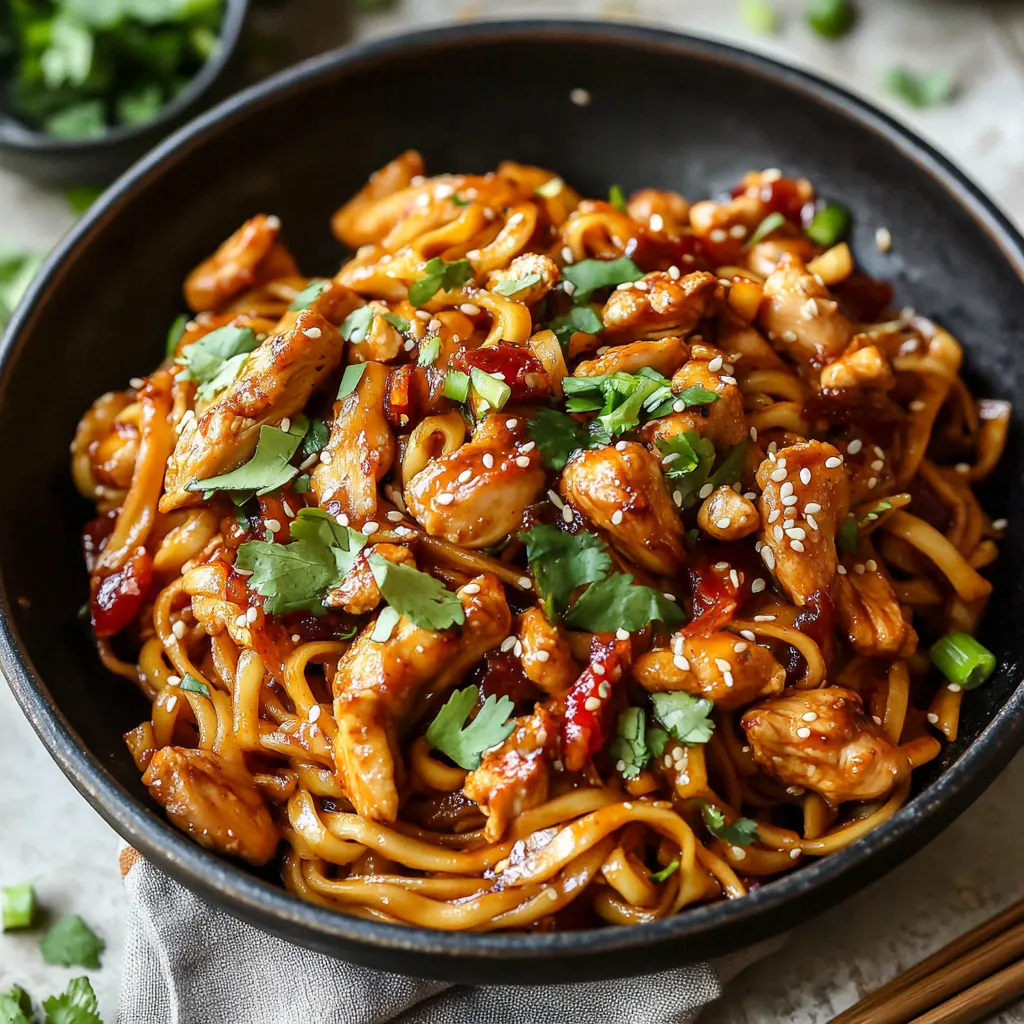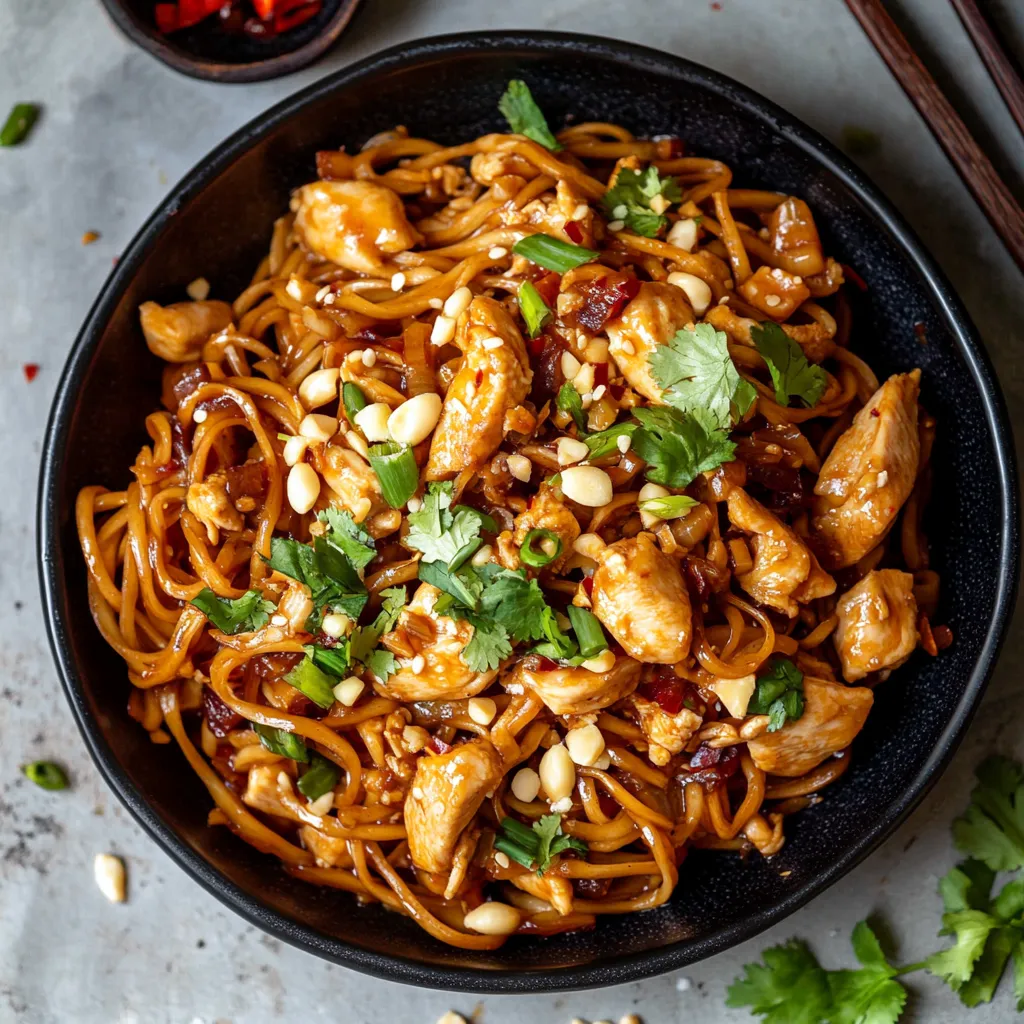 Pin
Pin
On hectic weeknights, these filling Kung Pao chicken noodles have become my family's favorite dinner fix. They've got that amazing mix of hot, sweet and rich flavors that turns simple noodles into something you'd swear came from your favorite restaurant. My family asks for this dish almost every other week now.
I threw this together one night when I wanted takeout flavors but something fresher and better for us. What started as just playing around with stuff in my pantry has turned into one of those meals my family constantly asks for, especially when we're running short on time but still want something that'll fill us up right.
What You'll Need
- 12 oz noodles of your choice: Go for rice noodles if you can't have gluten or pick udon for something with more bite
- 1 lb chicken breast: Choose fresh, thick pieces with no odd coloring for the most tender results
- 3 tbsp low sodium tamari: Gives you that deep savory taste without making it too salty
- 1 tbsp honey: Brings just enough sweetness to balance the spicy kick
- 3 tbsp chili paste: Sambel oelek works best but any Asian-style chili sauce can do the job
- 2½ tbsp toasted sesame oil: Creates that wonderful toasty smell that makes the whole dish pop
- ½ cup diced green onions (white parts): Forms a gentle flavor foundation for everything else
- 1 tbsp minced garlic: Go with fresh for the best taste but the jarred stuff works when you're in a hurry
- 1 tbsp peanut butter: Adds that smooth texture and classic Kung Pao depth
- 2 tbsp rice vinegar: Brings a tangy zip that cuts through the richer flavors
- 1½ tbsp brown sugar: Helps everything brown nicely and adds complexity
- ¼ tsp ground ginger: Gives a subtle warmth without taking over
- ½ tsp red pepper flakes: Creates a nice slow-building heat
- 3 tbsp water mixed with 1 tbsp cornstarch: Makes the sauce stick to everything perfectly
- ⅓ cup crushed peanuts: Gives that must-have crunch and traditional finish
- ⅓ cup diced green onions (green parts): Adds brightness and a fresh color pop
How To Make It
- Prep Your Chicken:
- Slice chicken into 1 inch chunks so they cook evenly and soak up more flavor. Mix with tamari, honey and chili paste, making sure every piece gets covered. Let it sit for 12 hours if you can, but even 30 minutes works in a pinch. The mix starts softening the meat while the flavors work their way in.
- Cook Your Noodles:
- Get a big pot of water boiling and add enough salt so it tastes like ocean water. This gets flavor into the noodles themselves. Toss in your noodles and cook them just as long as the package says, stirring now and then so they don't clump up. Check them often since mushy noodles will ruin the final dish. Drain them well but don't rinse them or you'll wash away the starches that help the sauce stick.
- Mix Up The Sauce:
- Put tamari, peanut butter, rice vinegar, chili paste, brown sugar, ground ginger, sesame oil and red pepper flakes in a bowl. Stir like crazy until the peanut butter blends in completely with no streaks. Getting everything mixed well means every bite will taste the same. This combo gives you that signature Kung Pao flavor that hits all the notes of heat, sweet, tang and richness.
- Start The Cooking:
- Warm up the sesame oil in a big pan on medium-low until it looks shiny but isn't smoking. Throw in the white parts of your green onions and cook them for 2-3 minutes until they soften and turn see-through. This brings out their sweetness and tones down their sharpness. Add your garlic and cook just one minute more. Watch it closely since burnt garlic will make everything taste bitter.
- Cook Your Chicken:
- Put the chicken pieces into the pan with the onions and garlic, leaving behind any extra marinade that might make things too wet. Spread them out so they aren't touching and let them sit for 2-3 minutes until they get golden on one side. Flip each piece and cook another 2-3 minutes until they reach 165 Fahrenheit inside. This way they'll brown nicely without getting tough and rubbery.
- Make The Sauce Thicker:
- Pour your sauce mix into another pot on low heat. Stir it while it warms up to keep it smooth. In a small bowl, mix your water and cornstarch until there aren't any lumps. Slowly pour this into your warming sauce while stirring constantly. Let it bubble gently for 1-2 minutes until it gets noticeably thicker and looks glossy.
- Put Everything Together:
- Drop your cooked noodles straight into the thickened sauce and use tongs to toss them around until every noodle gets coated. The starch from the noodles will help the sauce stick even better. Add in your cooked chicken along with any juices from the pan. Gently fold everything together so you don't break up the noodles or chicken.
- Finish It Up:
- Let everything simmer together for another minute or two so the flavors can mix and the noodles can soak up some sauce. Scoop it all into bowls and sprinkle generously with your crushed peanuts and the green parts of your green onions. The different textures and fresh green flavor really make this taste like something from your favorite restaurant.

Chili paste really makes this dish special. I found sambel oelek at an Asian grocery store years back and it totally changed how I cook at home. Unlike sriracha that already has garlic and sugar mixed in, plain chili paste lets you decide exactly how everything should taste. My kids were worried about the red color at first, but now they know it means their favorite dinner is coming.
Keeping Leftovers
This dish keeps surprisingly well for about 3 days in the fridge. Store it in containers that seal tight, preferably glass ones that won't get stained by the chili paste. The flavors actually get better overnight, so leftovers sometimes taste even better than when you first made it. If you notice the noodles have soaked up too much sauce and seem dry when you reheat them, just add a small splash of chicken broth or water while warming them up. Don't try freezing this one though, as the noodles get mushy when thawed out.
Making Changes
What's great about this dish is how easily you can switch things up. You can swap out the chicken depending on what you have. Shrimp cooks even quicker than chicken, while tofu needs a bit more work to get right. If using tofu, press the extra firm kind for 30 minutes before cutting it up, and think about coating it in cornstarch before frying for extra crispiness. Veggies work great too. Try adding bell peppers, snow peas, broccoli, or mushrooms in the last few minutes of cooking. For fewer carbs, use half the noodles and mix in some spiralized zucchini or carrots.
Adjusting The Spice
As written, this recipe has a medium heat that most people who like spicy food will enjoy. If you're sensitive to spicy stuff, cut the chili paste down to 1 tablespoon and skip the red pepper flakes altogether. You'll still get that Kung Pao taste from the other ingredients. If you really love heat, add 1-2 crushed dried Chinese chilies, or bump up the red pepper flakes to a full teaspoon. Just remember that it gets spicier the longer it sits, so leftovers will usually have more kick than when you first made it.

With just a bit of prep work, these Kung Pao chicken noodles will become your go-to meal, giving you restaurant-quality food right in your own kitchen.
Recipe Q&A
- → Can I make Kung Pao Chicken Noodles less spicy?
You bet! To tone down the heat, just cut back or skip the red pepper flakes and go lighter on the chili paste in both your marinade and sauce. You can tweak these parts to match how hot you like it while keeping all the great flavor.
- → What type of noodles work best for this dish?
You've got plenty of options including rice noodles, egg noodles, udon, or regular spaghetti. Rice noodles keep things gluten-free when you use tamari. Go for thicker noodles if you want more bite, or thinner ones for something lighter.
- → Can I add vegetables to this Kung Pao dish?
Definitely! Broccoli and bell peppers fit in perfectly as the recipe mentions. You can also toss in snap peas, carrots, zucchini, or water chestnuts for extra crunch. Throw them in while cooking the chicken or mix in already-cooked veggies at the final stage.
- → Can I substitute the chicken with something else?
For sure! Tofu, shrimp, or beef all make good stand-ins. For veggie versions, grab some extra-firm tofu or load up on more vegetables. Just watch your cooking time—shrimp needs less time while beef might take a bit longer.
- → How can I store leftover Kung Pao Chicken Noodles?
Pop leftovers in a sealed container in the fridge for up to 3 days. When you warm it up, add a little water or chicken broth to freshen the sauce, since noodles soak up liquid while sitting. Warm it slowly on the stove or in the microwave until it's just hot enough.
- → Is there a substitute for peanut butter in the sauce?
You can swap peanut butter with almond butter, sunflower seed butter, or tahini if you've got peanut allergies. Each option will change the taste a bit but will still make a yummy sauce. For something totally nut-free, try tahini with a bit more sesame oil.
